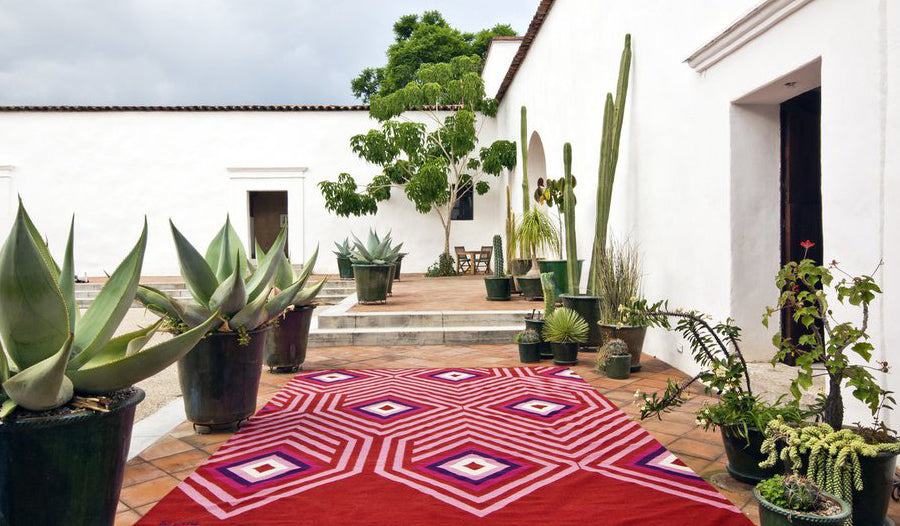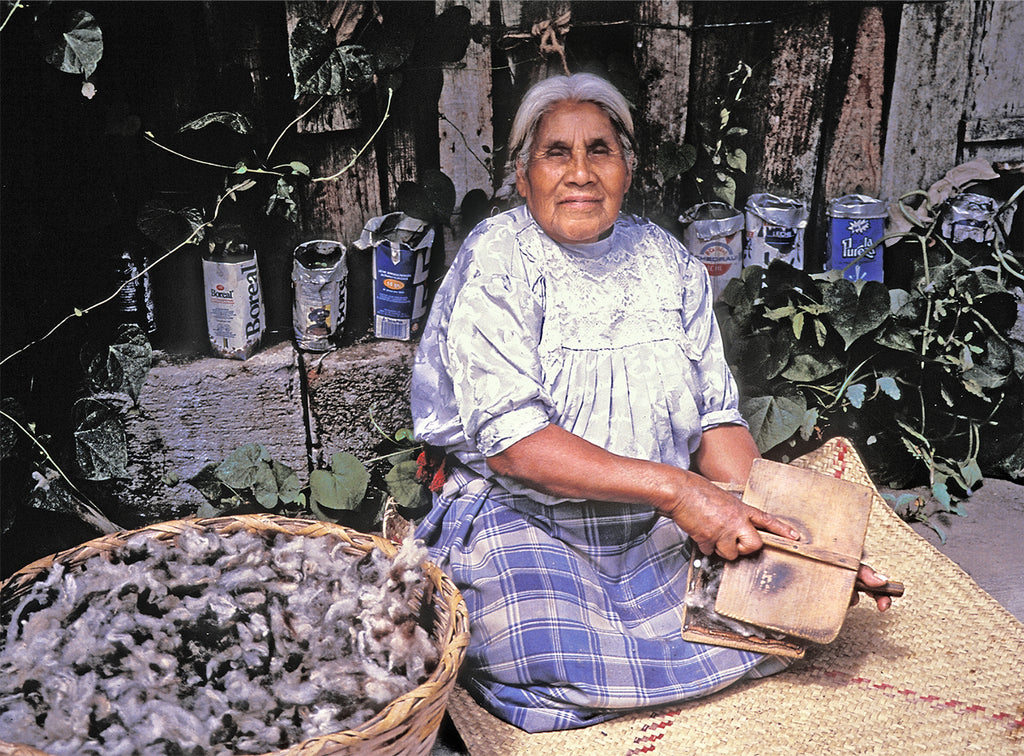
The Long Thread #1
We're pleased to announce the first in our series of longer blog reads. We plan to publish these more in-depth articles on Thursdays every two weeks — perfect for a tea break! Our first is written by Chloë Sayer, a mine of information about Mexican traditions, textiles and popular art.

The Mexican state of Oaxaca, dominated by rugged mountains and high valleys, is home to a vast indigenous population. Sixteen different languages are spoken in scattered communities, where inherited traditions include the making of fine textiles. The Zapotec people — the largest indigenous group in Oaxaca — have been a cultural force in Oaxaca for at least 3,000 years, and their language has over 410,00 speakers. Modern Zapotec creativity finds expression in visually splendid festivals and complex craft skills.
As in the past, the ancient Zapotec town of Teotitlán del Valle remains an important weaving centre. Before the Spanish conquest, Oaxacan weavers were predominately female: they clothed themselves and their families using locally grown cotton and the backstrap loom. After the introduction of wool flocks in the mid-16th century, however, wool became the dominant fibre, and men learned to use free-standing European treadle looms. Teotitlán del Valle became known for its eye-catching sarapes (rectangular over-garments with an opening for the head). While women focused on carding, spinning and dyeing wool, male weavers became adept at patterning cloth on the loom. A few young women now work with treadle looms, but these gender roles still predominate in most of Teotitlán's extended-family workshops, where several generations work harmoniously together in shady interior courtyards.

In recent years, the sarape (once a symbol of masculine identity and nationhood) has been replaced by handsome rugs, runners, and wall-hangings for the home. Tapestry techniques, where discontinuous weft threads cover the warp threads, enable weavers to pattern cloth in a variety of ways. Designs change as fashions change. Some rugs carry stylized flower, animal or bird motifs. Others echo Zapotec designs borrowed from the archaeological sites of Mitla and Monte Albán, or replicate the paintings of European artists such as Klee, Picasso or Escher. Navajo-inspired designs have also proved popular, as have Catholic saints and religious symbols, lifelike portraits of historical figures, and realistic landscapes.
Skilled weavers are increasingly reworking the complex geometrical formations that characterized 18th- and 19th-century sarapes. Designs include small triangles, rhomboids, hour-glasses and ovals grouped round a central lozenge or medallion. This trend was started by the late Arnulfo Mendoza Ruiz (1954-2014). After seeing an exhibition of antique sarapes, he decided to try and replicate the complexity of these interlocking motifs, and to celebrate what he saw as a truly Mexican aesthetic. This virtuoso Zapotec weaver helped to revitalize tapestry-weaving skills for future generations, and his status as a pathfinder lives on. Because Arnulfo had trained as an artist — he was a painter as well as a weaver — he liked the vibrancy of some synthetic dyes, especially those of Ciba-Geigy, and enjoyed combining them with local dyes like cochineal. Today, however, the weavers of Teotitlán take pride in the resurgence of natural dyes, and rarely admit to using chemical colourants.

Pedro Mendoza Gutiérrez is a master dyer. Born in 1975, he learned his skills from his parents. "My ancestors, like most people here Teotitlán, would spend half the year weaving and the other half growing maize, beans and chickpeas the feed the family. I started weaving when I was eight years old. By the age of ten I could elaborate my own designs. Out of a population of maybe 6000, I would say that 60 percent of us are weavers. When I was growing up, natural dyes were little used. The decline started after 1910, as anilines and other synthetic dyes became available. But older dyers kept the skill alive. Now I teach my children, Diana and Abner, how to use the resources that we have inherited. Like every parent, I hope that one day they will surpass me."
Pedro's woven geometric masterpieces incorporate a range of local dyes. Wool is washed with amole (a native root said to ward off clothes-moths and other insects), then spun on a European spinning wheel. Four main colourants provide a range of shades. Mexican indigo is used for blue-black tones. The parasitic cochineal insect (Dactylopius coccus) feeds on the nopal (prickly pear cactus) of the genus Opuntia. Depending on the type of mordant used, cochineal provides Pedro with over 25 shades ranging from brilliant crimson to reddish-black. The third dyestuff is huizache (Vachellia farnesiana, also known as Acacia farnesiana, and previously as Mimosa farnesiana). Seedpods from this evergreen tree have a high concentration of tannin, and provide a black pigment. Musgo de roca (rock moss or lichen) gives yellow tones and completes the quartet. As Pedro proudly explains, he can achieve 126 different colours using these four basic dyestuffs. Other traditional dyes can increase his range. Mordants include lime juice, salt and alum (potassium aluminum sulfate). For Pedro, it's important to feel that he is upholding tradition, while at the same time giving free reign to his imagination.

The treadle looms of Teotitlán, constructed with a single back beam, are wider than they once were. This enables Pedro and other weavers to increase the span of cloth. Many looms now measure 2.3 metres (7 feet 6 inches) across, and incorporate three pairs of pedals. Some looms even reach 4 metres (13 feet 1 inch), and require five pairs of pedals. As the weaver moves from side to side, he operates the nearest pair. Designs, drawn first on paper, are traced on to the warp threads nearest the weaver; individual areas of pattern weft are pressed down with small wooden combs.
Flexibility, coupled with outstanding technical prowess, has led in recent years to a successful collaboration between weavers in Teotitlán and textile designer Marisol Centeno. Her company, founded in 2012, is called Bi Yuu — 'Air and Earth' in Zapotec. Based in Mexico City, Marisol offers a range of rugs, carpets and textiles for the modern home, made from "raw materials that age with beauty". Designs are inspired by Mexican modernist architecture. Proud of her long-term ties with the weavers of Teotitlán, she believes that the lengthy and intricate processes of weaving and dyeing are as important as the final product. They will, she hopes, "express inspiration and emotion through careful combinations of colour, texture and form, while upholding the traditions of Zapotec culture.
Written by Chloë Sayer
